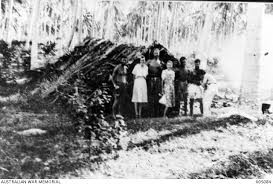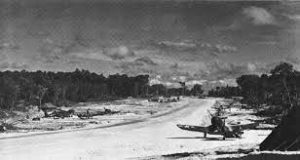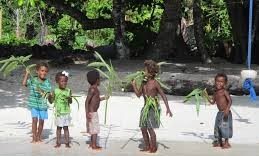Emirau Island: by Warren Martin
 Several traumatic and dramatic incidents occurred on the tiny, insignificant island of Emirau during World War II. Emirau is situated in the St Matthias group, less than 1½ degrees south of the equator. Overshadowed by its bigger brother, Musseau, it is only eight miles long and four miles wide; a true coral atoll, only a few feet above sea level at its highest point and with a poor quality and thin topsoil. Emirau supported only a few hundred inhabitants.
Several traumatic and dramatic incidents occurred on the tiny, insignificant island of Emirau during World War II. Emirau is situated in the St Matthias group, less than 1½ degrees south of the equator. Overshadowed by its bigger brother, Musseau, it is only eight miles long and four miles wide; a true coral atoll, only a few feet above sea level at its highest point and with a poor quality and thin topsoil. Emirau supported only a few hundred inhabitants.
In December 1940 the German cruisers Komet and Orion offloaded around 500 people, mainly civilians who were survivors of ships they had sunk. The newcomers totally overwhelmed the limited food supply of the island until they were rescued.
In March 1944, the US military decided to establish a light air and navy base on Emirau. They moved the 300 local people en masse to Musseau, scraped off the topsoil, built magnificent coronus roads and two large airstrips each around two miles in length, and installed 18,000 men and 40,000 tons of supplies. The Yanks were only there for a few months and when they left the Emirau people moved back and moved into the corrugated iron houses.
 My father, John Martin, who had spent three years in PNG during World War II, accepted a post-war offer to go back there as a ‘Seven Day’ missionary based on Musseau, with responsibility for church work on New Ireland, New Hanover and the St Matthias Group. We – my father, mother, three year old sister and nine year old me – arrived on Musseau in June 1949 and lived there for three years.
My father, John Martin, who had spent three years in PNG during World War II, accepted a post-war offer to go back there as a ‘Seven Day’ missionary based on Musseau, with responsibility for church work on New Ireland, New Hanover and the St Matthias Group. We – my father, mother, three year old sister and nine year old me – arrived on Musseau in June 1949 and lived there for three years.
We had an ex-army, three-piece two-way radio and we radioed Rabaul on the ‘sched’ several times a week. Although Kavieng was closer, some glitch meant we couldn’t be heard there. There was no radio on the mission boat, though. We used to report strange occurrences like planes flying overhead along with their direction. When there was an emergency, the Emirau people would light a bonfire. A villager on Musseau would see the fire and tell us and we would go the 20 miles to Emirau to see what the problem was.
On one occasion we were advised of the signal fire and went to Emirau. We were told about a submarine which had surfaced there. The sailors came ashore and, speaking with foreign accents, wanted fresh food. They were apparently disappointed that the islanders had no pigs to sell as they were all Seventh Day Adventists. We radioed Rabaul and told them and I believe it caused a bit of a stir. It was popularly believed to be Russian: most unexplained boats or planes were automatically assumed to be Russian.
I loved going to Emirau because of all the equipment the Yanks left there. Although they drove a couple of hundred vehicles over the ‘cliff’ into the water, there was still a lot of machinery left. There were jeeps, a large crane, a huge bulldozer still in its shed, caches of 44 gallon drums of fuel, the ice cream maker, a mountain of embossed Coca-Cola bottles that some enterprising person sold back to the States in later years, guns and ammunition, and a twin engine bomber parked at the side of one of the strips that had a couple of holes in its tail section but looked like it would fly if you fuelled it up. I loved to climb up into the cockpit and pretend I was flying it.
WR Carpenters apparently got salvage rights to the war surplus material on Emirau during our time there and a young man, Tom Walls, was employed to make an inventory. He and I became good friends and we shared a few common interests including the sacks of comics his sister used to send him; much to my parents disgust.
One trip to Emirau following the signal fire occurred after a villager, doing the right thing as he was told to do by my father, was burying some ½ inch cartridge shells. Rather than dig a hole, he was hammering them into the ground. The resulting explosion filled him with a lot of shrapnel and took off a lot of skin. We shipped him to Kavieng as fast as we could and he made a good recovery.
 There is a European grave site on Emirau with a headstone and wrought-iron fence around it in the name of Juanita Wilde. I don’t know the story – perhaps someone else does. Once when we were visiting Emirau, a Navy boat from Lorengau was also there. A naval seaman got swept away in a ship’s dinghy. The dinghy was found on a reef further around the island a few days later but no trace was ever found of the seaman.
There is a European grave site on Emirau with a headstone and wrought-iron fence around it in the name of Juanita Wilde. I don’t know the story – perhaps someone else does. Once when we were visiting Emirau, a Navy boat from Lorengau was also there. A naval seaman got swept away in a ship’s dinghy. The dinghy was found on a reef further around the island a few days later but no trace was ever found of the seaman.
I went back for the first time in 2004 and very little remains of any signs of the US military occupation, although the roads and airstrips are still there but in a poor state. I asked about the bomber and I was told that some one came and melted it down for its aluminium.



